For the Rocky Mountain State, agriculture means quality food, open space and a boon to the economic engine.
From fields of sunflowers to plains painted gold with corn and wheat; from ranges dotted with cattle to luscious orchards, vineyards and vegetable farms; Colorado produces a bounty of agricultural products. And Coloradans who bite into a sweet peach, chew through a juicy hamburger, sip a glass of artisan wine, or fuel up with a gasoline and ethanol mix, are likely consuming Colorado’s irrigation water while they’re at it.
When Major Stephen Long made his early expedition to Colorado’s Eastern Plains, or the “Great American Desert,” as he called it in 1820, he declared the region unfit for cultivation and uninhabitable for people sustaining themselves with agriculture. But later, when early farmers applied water to the region’s mineral-rich soils, life blossomed. “You just couldn’t stop stuff from growing,” says Dan Hobbs, an organic vegetable farmer and seed producer, who irrigates from the Arkansas River.
Over the past 150 years, Colorado’s combination of high-quality irrigation water from the mountains, its diversity of soils, and the arid climate—which reduces the incidence of crop disease—have supported local agriculture’s growth into a $40 billion industry. It remains one of the state’s largest economic sectors and employs 7 percent of the workforce.

Gregory Graff contemplates shrinking agricultural water supplies from a barren field at the CSU Agricultural Research Development and Education Center near Ft. Collins. Photo By: Matthew Staver.
But what if we took the water out of agriculture? Queue the eerie music. Now dissolve the corn, fade out some cows, erase the onions and potatoes, board up a few factories, close a dozen schools and focus on that list of Colorado ghost towns—it seems to scroll infinitely on and on. “It’s a bit of a doomsday scenario,” says Gregory Graff, an agricultural economist at Colorado State University. Graff is imagining a situation that he doesn’t believe plausible— a Colorado where there’s no water for irrigation. “If we were to go all the way to zero irrigation we’d do a lot more grazing,” Graff says. Livestock, after all, can be raised (and often are) through much of the year on unwatered pastures rather than being fed corn, alfalfa and hay grown in irrigated fields. “It would certainly decrease the agricultural footprint drastically—but I really don’t believe in that scenario.”
The mosaic of Colorado is, however, changing, with farm and ranch land giving way as cities grow. Additionally, as state population booms, cities are bolstering their water supplies by buying up agricultural water rights and drying up farmland. This trend is projected to continue.
Though no one expects to find all of Colorado’s irrigation headgates closed, the state’s irrigated farm lands have been shrinking even as the production of food and fibers remains valuable. With about 86 percent of Colorado’s water diversions going toward irrigated agriculture on only about 4.5 percent of the state’s land, even a 10 percent reduction in irrigation water—a more likely future— will mean a different Colorado economically and probably environmentally.
A Multi-Billion-Dollar Industry
Colorado’s farm and ranch production is currently a $6.4 billion industry in farmgate receipts, according to a 2011 CSU report. Yet there are many activities tied to production beyond the farmgate. The CSU study estimates that Colorado’s agricultural production, manufacturing, processing and inputs contribute more than $40 billion to the state’s economy annually. This vast industry is still fueled primarily by family farmers— husbands, wives and their children.
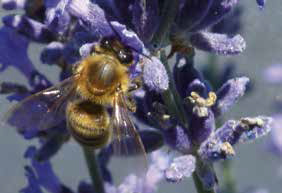
Specialty Crops—Winding through the Paonia area, a growing hops industry is supplanting overnight shipments from Washington state to supply Colorado’s many breweries. Lavender farms are also budding on the West Slope as an alternative cash crop that can co-exist with orchards and vineyards. Flowers are distilled into essential oils or used for cooking. Photo By: Lida Lafferty
Nearly $2 billion of Colorado’s agricultural sales are attributable to international sales. Colorado is currently ranked 24th in the nation in agricultural exports, with that number on the rise—Colorado’s agricultural exports increased by about 40 percent over the past two years. Over the past 40 years, while total farm sales in Colorado tripled from $1.7 billion in 1973 to $6.4 billion today, Colorado’s agricultural exports grew from $110 million to $1.84 billion—a 16-fold increase. “Those exports really create one of the driving forces for Colorado agriculture,” says Tim Larsen, international marketing specialist with the Colorado Department of Agriculture.
Not surprisingly, cattle along with dairy, corn, wheat and produce are Colorado’s big agricultural moneymakers and contributions to the global food market. “The rest of the world really needs Colorado’s wheat and they need our dairy products and our beef,” says James Pritchett, another agricultural economist at Colorado State University.
Colorado exports 80 percent of all wheat grown here internationally, is the top producer of millet in the country and ranks within the top five states in fed cattle, sheep, sunflower, lettuce, spinach, potato and cantaloupe production.
Already, an estimated one of every three Colorado food and agricultural suppliers sells some of
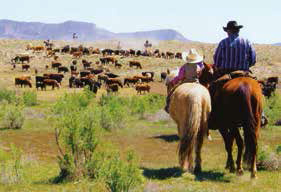
Agritourism—Colorado’s farmers and ranchers are increasingly developing tourism opportunities associated with their operations, ranging from corn mazes to dude ranches and bird watching. Colorado’s growing wine industry—now numbering 107 wineries statewide, most in and near the Grand Valley—is a big factor here. Photo By: Pat Martin
their product outside the United States. Colorado products were imported by 115 countries in 2012. But to see expanded sales, Larsen believes finding additional markets is key. In fact, it’s Larsen’s job to continue growing agricultural export opportunities for the state’s food producers. In the coming months, he’ll be meeting with buyers from South and Central America about potatoes, onions and dried beans, and bringing in Japanese importers of alcoholic beverages to sell them on Colorado’s 107 wineries, 139 breweries and 30 distilleries. Next he’ll hit Europe for an organic show and a pet food show.
Terry Fankhauser, executive vice president of the Colorado Cattleman’s Association, agrees with Larsen’s focus beyond our borders: “We produce more product than people can eat in this country.” The United States consumes about 16 percent of the beef produced worldwide, but produces nearly 25 percent of the world’s beef supply, Fankhauser says—and that is with less than 10 percent of the world’s cattle. “We’ve gotten more efficient and more effective in using genetics and yielding more, which means we’re using less water and resources to produce more.”
The United Nations estimates feeding a world population of more than 9 billion people by 2050 will require 70 percent greater food production than today’s levels. “If it’s not an option to curb population, then it has to be an option to figure out how we produce more food,” Fankhauser says. Fortunately, the greater non-irrigated mass of the state is ideal for range cattle production, says Fankhauser. “Cattle here are healthier; they’re robust; they’re in great shape.” In fact, Colorado’s 2.6 million beef cattle and calves comprise the nation’s 10th largest cattle herd.
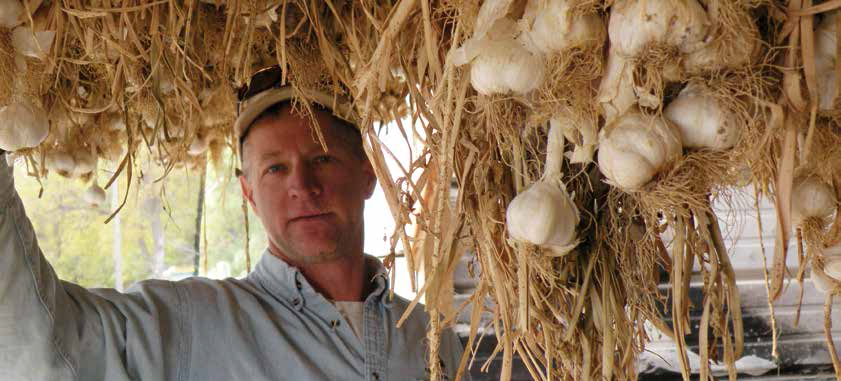
On his 30-acre farm, Dan Hobbs grows organic vegetable and seed crops, including nine varieties of garlic. Photo By: Greg Hobbs
Hovering just under $2 billion out of national export sales of $163 billion, Colorado still doesn’t play a tremendous role in meeting global food demands. Still, agricultural exports provide more stability in commodity prices and offer a big growth opportunity for the state’s producers, making them vital to Colorado’s economy. “We’ll never feed the world,” says Larsen. “But in key sectors, such as beef, wheat, potatoes and millet, we are already one of the primary exporters. We can be a global market leader.”

Top Producer—Colorado is the nation’s No. 1 producer of millet, an ancient and gluten-free grain used for flour and cereal as well
as bird seed. The state also ranks in the top 10 for production of lettuce, potatoes, onions, wheat, barley and dry beans as well as cattle and sheep. Photo Courtesy of: Colorado Department of Agriculture
As for meeting in-state demand, Graff says, “It’s not Colorado farmers feeding Colorado households on some sort of one-to- one relationship. Colorado farmers grow for the world and Colorado consumers buy from the world. There’s no exclusivity.” National and local food sourcing, at least in traditional large grocery stores, shows up merely as a cost factor. When a grocery conglomerate can import tomatoes more reliably and at a lower cost than purchasing locally, they’ll import. But while produce is in season in Colorado grocery stores typically source locally because it’s inexpensive.
The same concept applies internationally— Colorado produces beef at a lower cost than Japan or Korea because of our vast farm and ranchland, says Larsen. “They put a 40 percent import duty on our beef, and we still are in the Japanese market for a price lower than the Japanese-produced beef.”
When it comes to international imports, Colorado is largely importing products that add to quality of life, Larsen says. We obtain a lot of our fresh produce in the winter by importing it along with other year-round commodities like seafood, coffee and liquor.
It’s more difficult to track interstate trade, but Pritchett and Graff are working on collecting that information so researchers, the public and the state all have a better understanding of those flows of goods and services. Graff is also working with Gov. John Hickenlooper’s administration on an economic development initiative called “Colorado Blueprint.” His studies will inform decision-making and help make agriculture a more intentional component of the state’s economic development effort.
The Value of Water
Agricultural markets and impacted stakeholders trickle down from those international and national markets to the local level—to the Dan Hobbs-variety organic growers and to larger-scale producers who are planting and watering seeds or purchasing feeder crops to fatten livestock. Markets also impact rural communities across the state— more than half of Colorado’s counties are considered “ag-dependent.” In 24 of Colorado’s 64 counties, one in every 10 jobs is tied to agriculture; in 12 counties, it’s one in 43. “All these communities are connected to agriculture—it’s the base,” Hobbs says. “Look at a community like Ordway where a lot of the water has been sold out—it’s struggling mightily.”
Water for irrigation is key to much of the economic activity in Colorado’s rural communities. “Water is an important factor of production—you just wouldn’t be able to produce the same amount of crop or types of crops without that irrigation water,” Pritchett says.
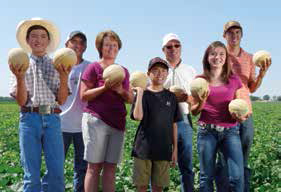
Sweet Relief—The authentic, world-renowned Rocky Ford cantaloupe made a comeback in 2012. Rocky Ford growers
invested nearly $1 million in upgraded safety procedures and implemented a public relations and marketing campaign to build
consumer confidence after the listeria outbreak in 2011. Photo courtesy of: Rocky Ford Growers Association
In 2006, Pritchett captured the value of irrigation water by studying the amount of economic activity generated by an acre of irrigated farmland. Average values ranged from about $1,235 per irrigated acre in the San Luis Valley to $335 per acre in the Arkansas Valley, but fluctuated widely depending on whether land was devoted to high-value crops or crops requiring substantial inputs. A 2012 report by the National Agricultural Statistics Service cites that an acre of irrigated cropland in Colorado is worth an average of $3,160 in real estate value alone, while an acre of non-irrigated cropland is worth $880, on average.
Other research has attempted to take into account more ancillary benefits of agricultural water, such as created wetlands. A 2012 study of the North Poudre Irrigation Company’s 56.8-acre area in northeastern Colorado found that 92 percent of the total wetland area in the region was a result of agricultural water storage and seepage through unlined irrigation ditches. Many consider that leakage to be waste water, says CSU wildlife biology professor Rick Knight. “Very few Coloradans appreciate that it’s creating wetlands; it’s probably creating the majority of wetlands in Colorado,” he says.
A similar study identified 1,400 acres of irrigation-dependent wetlands in the Boxelder Creek watershed nearby. The study found those wetlands added $2,200 per acre of value annually, for both the environmental and recreational benefits provided. The wetlands added some value simply by improving water quality, and additional value if hunting, fishing or bird watching was also available. “This study provides evidence of the potential magnitude of the benefits Colorado gets indirectly from agriculture,” says agricultural economist Chris Goemans, who worked on the study. “We need to consider what impacts moving water out of agriculture will have and how it will affect us.”
Shifting Dynamics
“It’s going to be a pretty different looking landscape in the countryside here in about 30 years,” Hobbs predicts. Midscale farms are beginning to disappear as farm size grows both bigger and smaller. To keep up with production costs, large farms are expanding further by amassing other agricultural parcels, while some land is being divided for small farms, which are becoming popular among people new to agriculture such as young people without a family farming legacy, hobby farmers and retirees.
At the same time, the local food movement has been expanding. “People are interested in where their food comes from. There are all kinds of new opportunities,” says Hobbs, citing the development of new cooperatives, which he helps foster with the Rocky Mountain Farmers Union.
According to Bill Stevenson, RMFU cooperative specialist, 68 cooperative projects in Colorado, Wyoming and New Mexico are currently underway with RMFU support. Cooperatives are user-owned, user-operated and user-benefiting organizations, Stevenson says. They allow food producers to market their fresh products in ways that are more efficient than what is otherwise available to them. That may be through a cooperative market, through a truck service that delivers fresh produce from farmgate to market, or through some other mechanism.
“The basic goal is to strengthen these family farm businesses and knit them together in such a way that they can build an economy of scale,” Hobbs says. “The reason for these co-ops is to do together what you cannot do alone.”
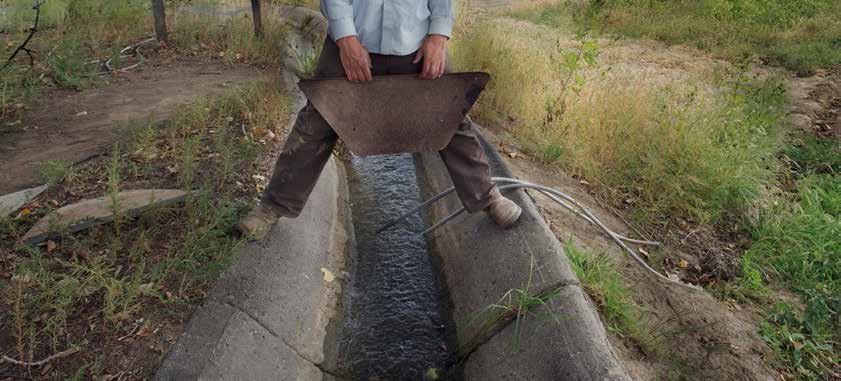
Dan Hobbs raises a floodgate over one of the lateral canals that irrigate his farm, an appropriate metaphor for the work he is doing in Pueblo County to unleash the cooperative power of a network of growers in reaching local markets. Photo by Bryan Kelsen
The state’s Colorado Proud labeling program, launched in 1999, has also been providing marketing opportunities for producers and making it easier for consumers to identify local products. Participating producers brightly label their product with the Colorado Proud logo and are listed on the website so that consumers can easily identify Colorado grown and produced products when grocery shopping or visiting restaurants.
Despite increasing consumer demand for locally produced foodstuffs, water for irrigation will likely continue to be sold out of agriculture to satisfy thirsty cities, though probably not in a quick horror-flick fashion. “Agriculture still accounts for 85 to 90 percent of water withdrawals in the state. Going down to zero, that’s hard to fathom,” Graff says. “Going down to 75 percent is going to be painful enough, and that’s probably the more realistic picture.”
What water remains will be more expensive, and it won’t make sense to irrigate lower value crops. “Those will be the acres we’ll lose, so we’ll have fewer irrigated acres of wheat and sorghum,” Pritchett says. “The values of fruits and vegetables and acres of those will stay constant—probably increase as population increases. You can’t have those crops without irrigation.”
The loss will extend beyond a change in production patchwork—it will disproportionately injure Colorado’s small rural towns. “So much of what they do has an agricultural pace to it,” Pritchett says. “You can’t replace the intensity of activity you have with irrigated agriculture with dryland agriculture. There would be less demand for goods and less demand for services in small towns. Those towns would suffer.”
Fankhauser also warns against moving too much water out of agriculture too quickly: “We don’t want to arrive at a time where we recognize that we need agriculture—that we need food—and the infrastructure that it takes to produce it is gone. We shouldn’t be talking about water leaving agriculture. We should be talking about how agriculture is going to need more water than it has now. We’re behind.”
No matter what, we will continue to be the spigot of the American West—we have the mountains, Graff says. “It’s a question of how much water there is in any given year, and then the competition with alternative uses of water. Those are social questions for society to answer.”

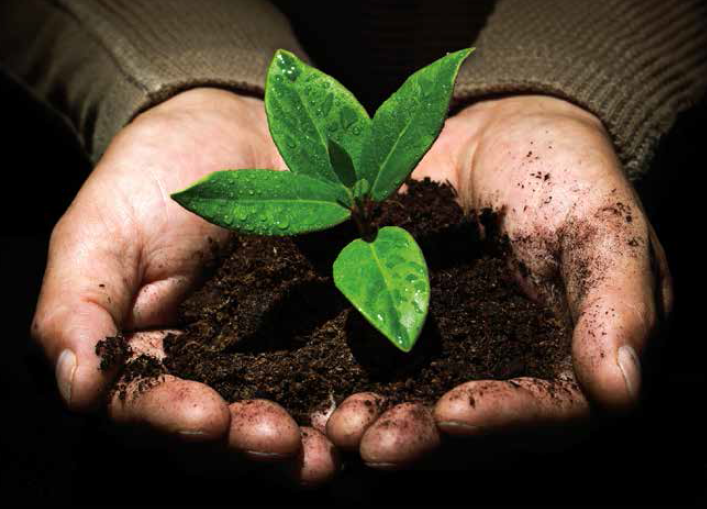
 Print
Print